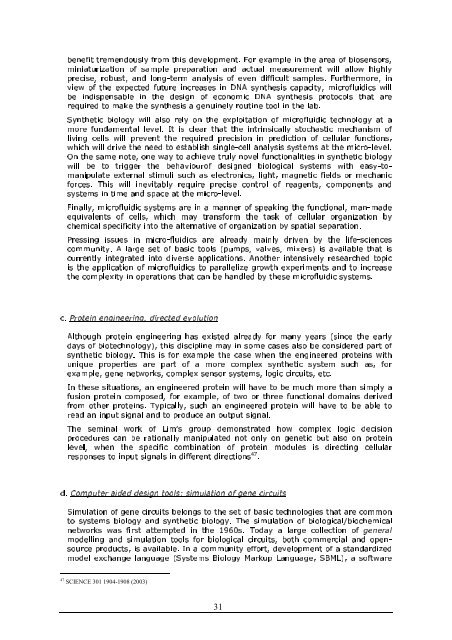Synthetic Biology Applying Engineering to Biology - Europa
Synthetic Biology Applying Engineering to Biology - Europa
Synthetic Biology Applying Engineering to Biology - Europa
Create successful ePaper yourself
Turn your PDF publications into a flip-book with our unique Google optimized e-Paper software.
tremendously from this development. For example in the area of biosensors,<br />
benefit<br />
of sample preparation and actual measurement will allow highly<br />
miniaturization<br />
robust, and long-term analysis of even difficult samples. Furthermore, in<br />
precise,<br />
of the expected future increases in DNA synthesis capacity, microfluidics will<br />
view<br />
indispensable in the design of economic DNA synthesis pro<strong>to</strong>cols that are<br />
be<br />
<strong>to</strong> make the synthesis a genuinely routine <strong>to</strong>ol in the lab.<br />
required<br />
biology will also rely on the exploitation of microfluidic technology at a<br />
<strong>Synthetic</strong><br />
fundamental level. It is clear that the intrinsically s<strong>to</strong>chastic mechanism of<br />
more<br />
cells will prevent the required precision in prediction of cellular functions,<br />
living<br />
will drive the need <strong>to</strong> establish single-cell analysis systems at the micro-level.<br />
which<br />
the same note, one way <strong>to</strong> achieve truly novel functionalities in synthetic biology<br />
On<br />
be <strong>to</strong> trigger the behaviourof designed biological systems with easy-<strong>to</strong>-<br />
will<br />
external stimuli such as electronics, light, magnetic fields or mechanic<br />
manipulate<br />
This will inevitably require precise control of reagents, components and<br />
forces.<br />
microfluidic systems are in a manner of speaking the functional, man-made<br />
Finally,<br />
of cells, which may transform the task of cellular organization by<br />
equivalents<br />
issues in micro-fluidics are already mainly driven by the life-sciences<br />
Pressing<br />
A large set of basic <strong>to</strong>ols (pumps, valves, mixers) is available that is<br />
community.<br />
integrated in<strong>to</strong> diverse applications. Another intensively researched <strong>to</strong>pic<br />
currently<br />
the application of microfluidics <strong>to</strong> parallelize growth experiments and <strong>to</strong> increase<br />
is<br />
protein engineering has existed already for many years (since the early<br />
Although<br />
of biotechnology), this discipline may in some cases also be considered part of<br />
days<br />
biology. This is for example the case when the engineered proteins with<br />
synthetic<br />
properties are part of a more complex synthetic system such as, for<br />
unique<br />
these situations, an engineered protein will have <strong>to</strong> be much more than simply a<br />
In<br />
protein composed, for example, of two or three functional domains derived<br />
fusion<br />
other proteins. Typically, such an engineered protein will have <strong>to</strong> be able <strong>to</strong><br />
from<br />
an input signal and <strong>to</strong> produce an output signal.<br />
read<br />
seminal work of Lim’s group demonstrated how complex logic decision<br />
The<br />
can be rationally manipulated not only on genetic but also on protein<br />
procedures<br />
when specific combination of protein modules is directing cellular<br />
level, 47 the<br />
input signals in different directions .<br />
<strong>to</strong> responses<br />
of gene circuits belongs <strong>to</strong> the set of basic technologies that are common<br />
Simulation<br />
systems biology and synthetic biology. The simulation of biological/biochemical<br />
<strong>to</strong><br />
was first attempted in the 1960s. Today a large collection of general<br />
networks<br />
and simulation <strong>to</strong>ols for biological circuits, both commercial and open-<br />
modelling<br />
products, is available. In a community effort, development of a standardized<br />
source<br />
exchange language (Systems <strong>Biology</strong> Markup Language, SBML), a software<br />
model<br />
systems in time and space at the micro-level.<br />
chemical specificity in<strong>to</strong> the alternative of organization by spatial separation.<br />
the complexity in operations that can be handled by these microfluidic systems.<br />
c. Protein engineering, directed evolution<br />
example, gene networks, complex sensor systems, logic circuits, etc.<br />
d. Computer aided design <strong>to</strong>ols: simulation of gene circuits<br />
47 SCIENCE 301 1904-1908 (2003)<br />
31




